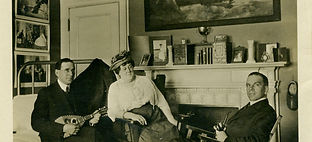
HISTORY OF THE CHARLES CLARK CHATEAU
The Clark Chateau was built by copper magnate William A. Clark for his oldest son Charles in 1898. It was designed by architect William S. Aldrich and based on a French chateau the younger Clarks had seen on their honeymoon. Aldrich received his degree from the Massachusetts Institute of Technology in 1884 and was in Butte from 1898-1900 to oversee the construction of the Chateau.
Charles Clark and his wife, Katherine, lived in the house for just a short time before Charles slipped away to California in 1903, following charges that he bribed a judge in a mining suit. Katherine died in January 1904 in New York City shortly afterwards of a illness.
The house was sold to Pat Wall in 1906, a mining investor in East Butte. He sold it in to Creighton Largey, son of murdered banker and merchant Patrick Largey. The Largeys wanted a home where they could entertain their friends and where they could live as well. Creighton's mother, Mrs. J. W. Catron lived across the street. In 1910, the Montana state song was composed in the music room, at a reception following a theatrical performance at the Broadway Theater.
In 1915, James A. Murray purchased the Chateau. The Butte College of Music was located in the building from 1917 to 1919, offering lessons in voice, piano, and stringed instruments. His nephew, James E. Murray and Viola Murray and their six sons moved into the house in 1928 and hired Marshall Field and Company of Chicago to decorate the interior. The family lived there until 1945. Judge W. D. Murray and his wife Lulu lived in the house with the elder Murrays from 1942-1945. James served as a U.S. Senator from 1934-1961. He was a staunch liberal and supporter of FDR's New Deal programs, and frequently butted heads with Montana's other senator, Burton K. Wheeler. He was also a fierce activist for the Irish Free State, and was part of the Butte effort to support the Irish Republican Army during the Irish War of Independence (1918-1921).
The Shriners occupied the building from 1949 until 1976, and used it as The Fez Club. The building was used for social events, wedding receptions, and Shriner's activities.
It was purchased by the Silver Bow Centennial Committee and sold to the city of Butte in 1977 for use as an arts center and museum. The Chateau is owned by the local government and operated by Chateau staff under the direction of the Butte-Silver Bow Public Archives.
The Mission of the Charles Clark Chateau is to preserve the historic building under the ownership of Butte-Silver Bow and encourage it's active use by providing a space and support for the community and visitors to gather and engage in cultural, artistic and humanities programming. The Root & The Bloom Collective, a non-profit organization, raises funds to support the art and culture programming for youth and adults provided by the Charles Clark Chateau. Through grants, donations and volunteer time, they support and ensure that the arts and humanities programming at the Clark Chateau keeps this historic building thriving as a vibrant community space.
Frequently Asked Questions
How BIG is the Clark Chateau?
The Clark Chateau has 4 floors, 26 rooms, 7 fireplaces and is approximately 13,000 square feet.
Which Chateau is it modeled after?
Our Chateau is likely modeled after the famous Château de Vizille near Grenoble, which was built between 1600 and 1619. Now an Art museum. Possibly modeled after the Chateau de Chenonceau, but the resemblance is more striking to the Chateau de Vizille.
How much did the Chateau cost to build?
$75,000 in 1898, which equates to approximately $2.7 million today.







_edited.jpg)